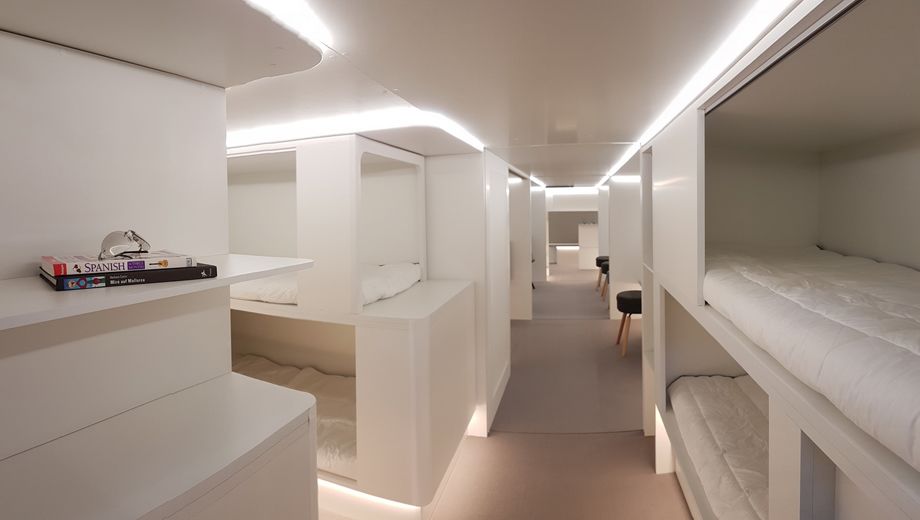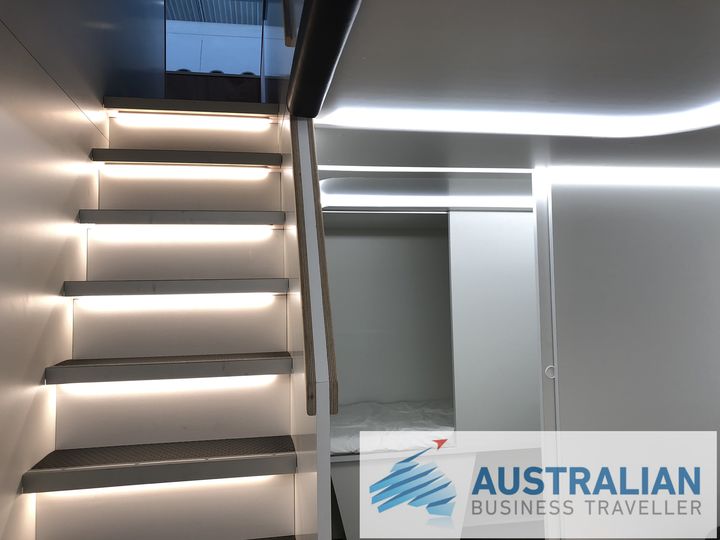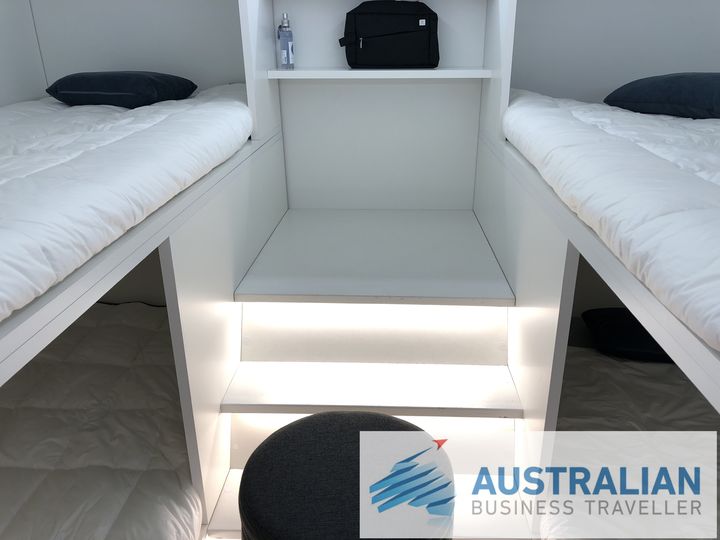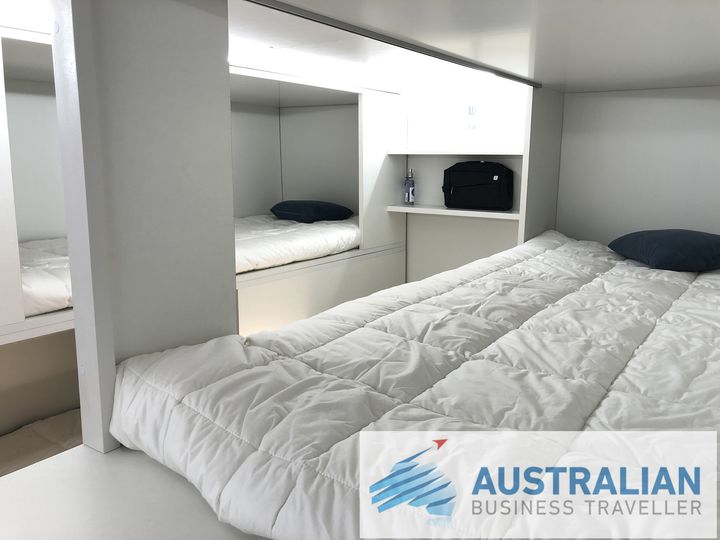Photos: how Airbus plans to put passengers in the cargo hold

EXCLUSIVE | Join Australian Business Traveller as we go below decks on a tour of Airbus’ innovative design concept for putting passenger lounges and bunk beds into an aircraft's cargo hold.
I’m at the sprawling Airbus headquarters at Toulouse, France, but visiting a part of it which very few people see: the cabin mock-up centre where airline executives come to decide on fitting out their new Airbus jets.
Those decisions are aided by full-size cabin mock-ups of the Airbus commercial jet family, from the nimble single-aisle Airbus A320neo (above) to the mighty A380 superjumbo (below).
But tucked away out of sight, down two levels of gantry stairs in this already high-security building, is what may be the next leap forward in cabin design for ultra-long range aircraft: custom-designed 'lower deck modules' which transform part of the cargo hold into a sky-high version of a railway sleeper berth.
Airbus is pitching the concept at airlines making ultra-long flights, as a way to provide additional space for passengers without taking away from the precious real estate of the main cabin.
Upstairs, downstairs…
After the flight takes off and reaches cruising altitude, you’d descend a set of stairs located near the front of the upper deck.
This takes you into a customised crib built to the same footprint as a standard aircraft cargo container.
In this mock-up, Airbus has stitched together several such modules to create a single flowing space.
The first area contains six single bunk beds, with steps so that passengers can climb to the upper bunk.
This is what Qantas CEO Alan Joyce has suggested could be "a new class" of travel with "berths like on a train" for the globe-striding jets of the airline's ambitious Project Sunrise, which aims to link Sydney and Melbourne non-stop to London and New York by 2022.
(That said, the current design doesn’t permit these spaces to be occupied during take-off and landing. Passengers would pay for both a regular seat upstairs – perhaps in premium economy or economy – and a bulk bed below.)
Several shelves provide space for cabin bags and other personal items.
A lower-deck lounge?
Past the bunk beds are modules shaped more around seating to provide travellers with a different, more social space.
A sliding door opens to reveal what is ostensibly a meeting room above the clouds...
... with banquette seating for nine people wrapping around a conference table.
This is just one take on what could be offered as a more open exclusive lounge for business class and first class flyers, as Airbus suggests in this sketch.
A more casual version is this corner area…
… while there’s also a small refreshment bar which Airbus has dressed up with drinks.
This more Spartan space, dressed with only a handful of chairs, allows the Airbus boffins and airline executives to toss around other ways in which a passenger module could be used.
Possibilities already on the blackboard include a family room...
... and even a medical facility.
Max headroom
I'm not an overly tall guy – at 1.75 metres, I'm bang on average for the European male – but with the ceiling height around 1.6 metres, moving around this below-decks space requires me to be crouched over and scuttle along with measured steps.
The straight lines, flat surfaces and overwhelming whiteness of the space feels as if I’m in a submarine designed by Ikea.
This in turn makes me ponder how a good designer – individuals such as Qantas’ David Caon or Cathay Pacific’s Ilse Crawford, or the teams at PriestmanGoode or JPA Design – could use colours, materials, textures and gentle lighting to transform this blank palette into a cosy den.
There’s still plenty to be done before Airbus can bring this concept to market around 2020, but the company is already pitching the idea to Qantas in the Project Sunrise bidding war, which will see the long-legged A350ULR going up against the next-generation Boeing 777X.






















24 Feb 2017
Total posts 14
They could paint the walls/ceilings yellow and stream "We all live in the Yellow Submarine" on playback repeat. :)
Qantas - Qantas Frequent Flyer
02 Jul 2011
Total posts 1374
Perfect to test out the fake/tv screen windows with.
Virgin Australia - Velocity Rewards
07 Dec 2014
Total posts 170
Curious how you would evacuate the space in an emergency within the 90 second requirement ... presumably because you have seating upstairs for take off and landing the theory is you wouldn't need to, but wonder what regulators would make of that.
Virgin Australia - Velocity Rewards
14 Mar 2017
Total posts 152
You just answered your own question.
24 Apr 2016
Total posts 23
Passengers are not allowed to be in the cargo hold during taxi, take-off, landings.
In an emergency landing, all the passengers wouldn't be allowed to be in the cargo hold.
04 May 2018
Total posts 43
moa999 +1
04 May 2018
Total posts 30
Interesting. So you would have to be in a seat upstairs for takeoff and landing. Then you go are down stairs and settle in, on comes seatbelt sign for turbulence or whatever reason does that mean you have to be woken up if sleeping and all make a mad dash upstairs to your seat and strap yourself in.
31 Jan 2017
Total posts 9
Makes no sense to me as these module style units and locking features will probably be heavier in weight than the Cargo & Mail they replace. When you consider all the extra cost and logistics positioning these various units around an Airlines network , then surely freight is a far more practical and profitable revenue means.
26 Jul 2015
Total posts 80
Back to the old days of the Boeing Stratocruiser.
Singapore Airlines - The PPS Club
11 Jul 2014
Total posts 51
I see this concept providing great flexibility/utilisiation for the fleet. If QF fit/provide on the upper deck the number of business seats required for medium haul, e.g. Asia, this is typically less than long haul (US & Europe). Then add the bed module or two when travelling to Europe and the US. Most typical J class flyers would be happy with a premium economy seat and a bed downstairs
22 Dec 2012
Total posts 35
The bunk beds look absolutely fantastic, I would definitely pay for this on a long-haul red-eye flight. With modern materials (e.g. carbon fibre) it would be easy to build lightweight bunk beds. I wouldn't be surprised if the bunks stack three high.
29 Mar 2018
Total posts 21
What a terrible idea. How much would they charge for this space to make it more profitable than cargo? At only 1.6 metres high most people would not even be able to stand straight up. Hate to be walking around down there when you hit turbulence.
Qantas - Qantas Frequent Flyer
22 May 2018
Total posts 73
Toilets??? Would you have to dash upstairs???.
It looks like it would be a "quiet zone".. an odd snorer or two on a top bunk could produce some interesting interactions.
17 Sep 2015
Total posts 371
Rail sleeping (not 'sleeper') berths always have windows.
23 May 2014
Total posts 118
I think the premise is you aren’t going to be carrying much freight on these ULH routes. The economics wouldn’t stack up given how much extra fuel you’d need at the beginning of the flight, and freight doesn’t mind an extra stop en route (plus almost nothing is so time critical that a 4 hour saving is worth the extra cost). And pax bags don’t take up all of the available space.
23 May 2012
Total posts 35
It won't be sleeping as that cannibalises J. At 1.6m clearance it's hard to think of a logical use other than a bar - which then begs the question, who gets to go there? The J bar on VA1 had the same four people sitting there for almost 10 hours last time I flew it.
Emirates Airlines - Skywards
19 Jan 2018
Total posts 25
Interesting concept, but clearly there a many logistical and commercial questions yet to be asked and answered before this becomes a reality.
Virgin Australia - Velocity Rewards
14 Mar 2017
Total posts 152
"After the flight takes off and reaches cruising altitude, you’d descend a set of stairs located near the front of the upper deck."
I think its pretty clear who's going to use this. It's going to be expensive, and it's going to be for business and luxury travellers. Even at a higher density of bunks (coffin, anyone?), this would be impossible to justify for an economy traveller.
Qantas - Qantas Frequent Flyer
11 Apr 2018
Total posts 3
I've made this comment before on a previous thread. The height restriction of 160 cm will render the concept useless !
Cathay Pacific - The Marco Polo Club
28 Mar 2018
Total posts 2
Reckon this could be a great opportunity to have an area where adults with kids would be situated, that way noisy kids and babies could no longer disturb other pasengers.
Thai Airways International - Royal Orchid Plus
13 Jan 2017
Total posts 31
Travelling in a group - here is an idea. Say 4 adults. Biz class for 2, and Y for 2. After take off and meals, 2 biz class pax go down for a nap, and the 2 Y pax come up to use the J seats.
Halfway through the flight they swap over. Before landing everyone back to their original seats. Split the cost over the group to make it more economical
Thoughts?
Qantas - Qantas Frequent Flyer
03 Apr 2016
Total posts 2
Can't think of anything worse than being stuck in a 'hold' and paying a premium for it. Hygiene standards are pretty dismal these days with mankind sneezing and spraying, lack of hand washing etc.and companies cost cutting and quick turnarounds so that proper sanitisation is not carried through. How would they control noise, drinking, 'mile high, badly behaved kids and adults alike. For my money, increase the legroom and avoid seats being reclines in economy.
Hi Guest, join in the discussion on Photos: how Airbus plans to put passengers in the cargo hold